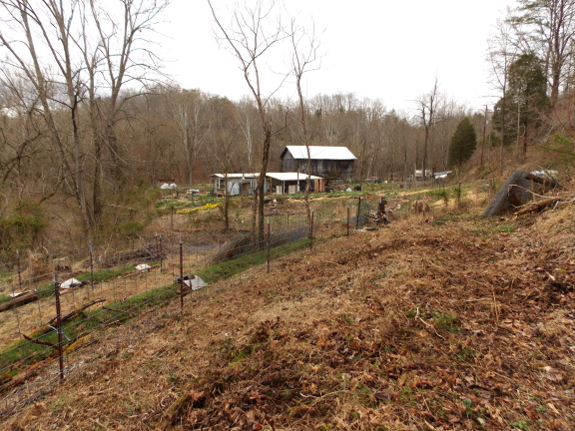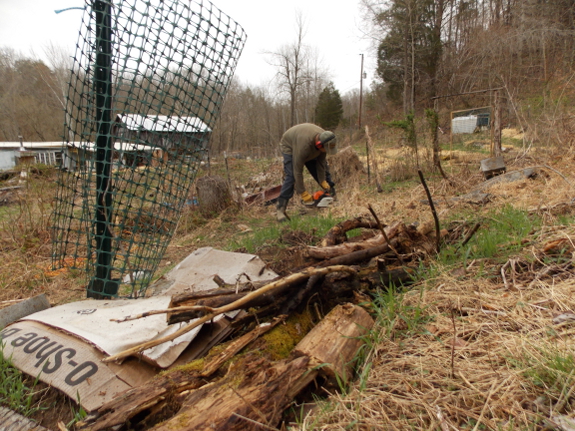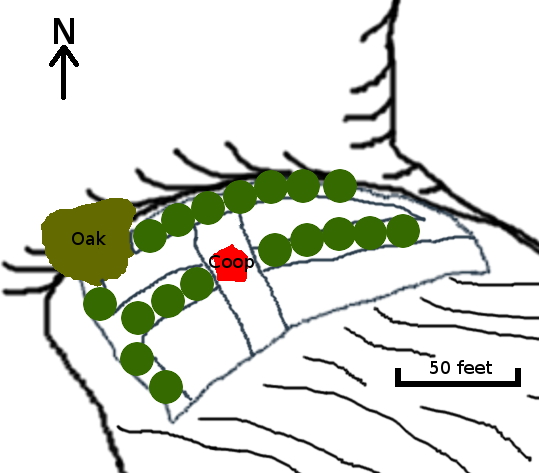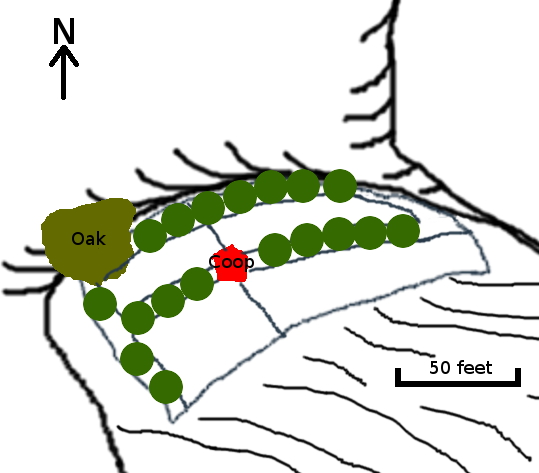
Planning fencing for the new pasture

Mark and I have just
about finished clearing out the closer half of the starplate
pasture. Last year, Mark cut down all the big trees, but there
were still stumps and logs to be cut into firewood, briars and honeysuckle to be ripped out, and plenty of punky wood to be thrown into the swales.
We've learned the hard
way that making the ground relatively even is a good idea in new
pastures so that mowing is simplified and non-chicken-friendly weeds
don't get out of control. Right now, all of the trip hazards are
obvious, but in a month or two, our exuberant greenery will take over
the ground, covering up stumps and vines. As my grand-nephew would
say, "That's a recipe for a lost flywheel shaft key."

Another thing we're doing differently in this new forest pasture is to plant the fruit trees in rows, making easier-to-care-for tree alleys.
By fencing all of the fruit trees into their own rows, any eventual
larger livestock can be kept out, and chickens can be allowed into the
alleys in small doses only so as not to over-fertilize the trees.
I'm getting a little
stuck on planning out the fencing for these tree alleys, though.
My goal is to minimize the number of gates involved, since each one
takes Mark an afternoon or so to build, making them the most
time-consuming part of the fencing process. I also want to ensure
easy human access to all parts of the pasture, limited chicken access to
the tree alleys and the other paddocks, and hypothetical large animal
access to the non-tree paddocks.

Here's one possibility,
which uses a central paddock the animals always have access to in order
to ease fencing and gates. I think that I can just unlatch a
corner of a livestock panel and prop it open to let chickens into each
paddock, which would mean we'd just need two gates to make it easy on
humans entering the pasture and then entering the permanent paddock in
the middle. The downside is that any permanent pasture will get
scratched bare in no time, so I'll either have to deal with mud around
the coop or will have to plan for some kind of mulch in this permanent
yard. One final upside is that the permanent yard can open out
onto the woods for winter chicken pasturing without scratching up
pasture areas I care about.

Another option is to do what we usually do and use popholes
to let chickens into the paddocks we want them in. The upside of
this method is --- no muddy mess around the coop! The downside is
--- if we want to add larger animals, we'll have to come back in and
make real doors for access, which might be tough. Another
potential issue is that there's no easy way to shunt chickens into the
woods for winter pasturing, but we work around that issue now using
temporary fencing and can do that again.
Using either of these
methods, I'll also need to decide how wide the tree alleys should
be. We'll be planting semi-dwarf apples and pears here, which are
usually spaced about 15 feet apart, but if I make the tree alleys 15
feet wide, there won't be much room in between. Once again, I'm
forced to decide between two imperfect scenarios: wide tree alleys that
"waste" a lot of pasture space but ensure large animals will never
nibble on the tree limbs, or narrow tree alleys that maximize pasture
area but possibly let hypothetical livestock eat lower limbs.
Which would you choose?
Want more in-depth information? Browse through our books.
Or explore more posts by date or by subject.
About us: Anna Hess and Mark Hamilton spent over a decade living self-sufficiently in the mountains of Virginia before moving north to start over from scratch in the foothills of Ohio. They've experimented with permaculture, no-till gardening, trailersteading, home-based microbusinesses and much more, writing about their adventures in both blogs and books.
Want to be notified when new comments are posted on this page? Click on the RSS button after you add a comment to subscribe to the comment feed, or simply check the box beside "email replies to me" while writing your comment.

Maybe I missed something, but could you just enlarge the "area" so that you can have both wider tree alleys plus decent-sized pastures? (I love goats & vote for having them!)
Another option: have you subscribed to Geoff Lawton's videos? http://www.geofflawton.com/sq/15449-geoff-lawton
He has a recent one on no-feed chickens, raising them entirely on compost. I you went with your first design, you could use the coop area to "process" your compost & feed the chickens. Dirt would not be a problem!
I love you guys! Thanks for all the wonderful content!!!! Peace, Terry
Eric --- I'm always pushing for big livestock and Mark's always pushing against, so whether we'll have them or not is up in the air. Goats are pretty low on the list, though. More likely, it would be pigs (which wouldn't bother the limbs at all) or sheep (which might). Even more likely is that we'd try another kind of small livestock --- rabbits.
Goats are pretty low on the list, though. More likely, it would be pigs (which wouldn't bother the limbs at all) or sheep (which might). Even more likely is that we'd try another kind of small livestock --- rabbits.
Terry --- It's a bit hard to tell from my drawings, but this is the one flat area in that vicinity. (Actually, it's not flat, but it's much flatter than the areas on either side.) So, we can't really enlarge the pasture without running up hills, which causes a lot of erosion.
Unfortunately, we don't have nearly enough food scraps to feed chickens on compost alone. During the height of the summer harvest, we have more due to processing, but mostly, we just have a quart or so per day, and most of that is things chickens won't eat like orange and onion peels. I've tried having chickens scratch through compost outside before, but at our levels, that just results in a somewhat rich spot of bare soil and no harvestable compost. We just don't waste much real food....
I would choose the first option since it appears to have the most long term flexibility (including dog access to protect from predators.) I would maximize the pasture and prune the trees high if you were concerned with animals browsing on the lower limbs. I would also minimize the tree alley width so the fruit can fall into the pastures. You are going to have a lot of apples when all those trees begin to bear and the pasture will probably be more valuable to you in the mature system.
Have you thought of a permanent path for when you check on the chickens every day? It may be nice if it could be built up (old tires packed with stones?) or mulched so you can get the bedding in/compost out easily even when it's muddy.
Do you have any plans for capturing any of the nutrient run off from the coop or fields or does the ground slope to the north so the trees would be the catchment? Do you have any swale or earthworks to aid in this catchment planned?
Remember you can always change your mind later if something doesn't work. Good luck in whatever you end up doing.
Brian --- Good thoughts! I'm thinking of having Mark put dog doors into the gates so Lucy can run right up to the coop --- that definitely has been a weakness of our anti-predator campaign in the past. She breaks holes in our fences so she can protect the flock at the moment....
Good point about eventual fruit fall and pruning trees high. It would be awesome if I could let the less good fruit that drops just be eaten up by livestock rather than picking it up, etc.
The ground does slope north, and I've been making swales and mounds for the tree alleys, so those trees should capture any runoff. I'm also planning on dumping duck pond water into other parts of the swales to fertigate the trees.
Good point about always being able to make changes later...
Your post was from awhile ago, so your decision likely has been made. Just wanted to point out a man in our area sells the best tasting beef, and his cows graze free-range around his gynormous orchards. He sells his beef cheap because he says they already pay for themselves by ferilizing and keep all his trees trimmed to the same height. Plus they mow the undergrowth so he doesn't have to pay people to do any of those jobs anymore.
Regarding your chicken pasture system, do you find that the birds just fly right out of the pen using the lovely permaculture trees you plant in there? Would it really work to have a 5 foot fence and say a 10 foot tree or tall rocks nearby? I just keep imagining that they would glide right out and be vulnerable to predators during the day (they're locked up at night). Thank you!